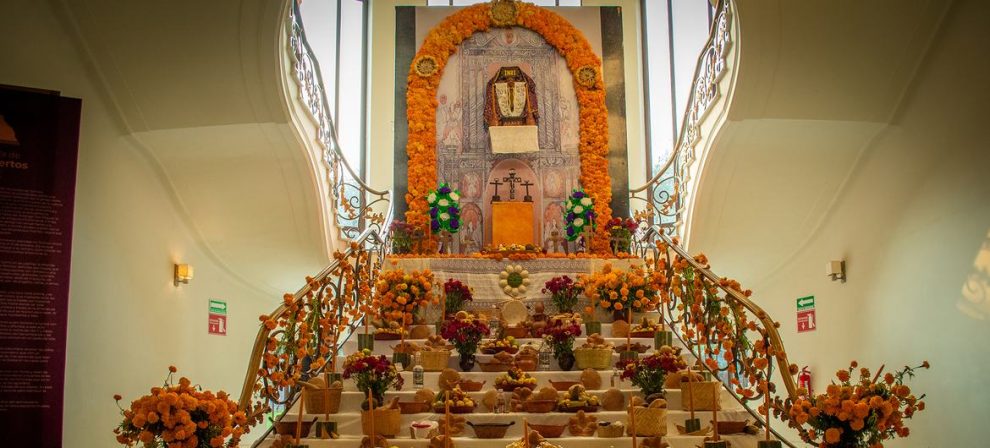The Day of the Dead (November 1 and 2) is a celebration of memory and life that is deeply rooted in the culture of the indigenous peoples of Mexico. Its origin is a fusion of the Catholic religious rituals brought by the Spanish and the commemoration of the Day of the Dead that the indigenous people carried out since pre-Hispanic times.
The festivals celebrate the temporary return of deceased loved ones, coincide with the end of the annual corn cycle, a key element in Mesoamerican culture, and are also part of the renewal of the political and social status of different indigenous communities.
The celebration varies depending on the town, municipality or state; however, throughout the country has the same objective: to bring families together to welcome their loved ones who return from the beyond.. November 1 is dedicated to girls and boys. On day 2 to adults.
In 2003, the indigenous festivals dedicated to the dead were inscribed on the Representative List of the Intangible Cultural Heritage of Humanity by the United Nations Organization for Education, Science and Culture (UNESCO).
Within the framework of the 79th anniversary of the United Nations and in the midst of a context in which 2 billion people in the world, a quarter of humanity, live in places affected by war or violence, levels unprecedented since the Second World War, UN Mexico joined these festivities.
In alliance with the Ministry of Foreign Affairs, the Ministry of Culture, the Los Pinos Cultural Complex and the Ministry of Culture of the state of Querétaro, UN Mexico invited a group of bearers of the Hñoñho Otomí tradition from the municipality of Tolimán, Querétaro, now a group of artisans from Huamantla, Tlaxcala, to make an offering in honor of the lives lost to wars, conflicts and suffering in the world, emphasizing the power of life, memory and hope.
The UN offering “Let us honor life and peace” is located in the Miguel Alemán House of the Los Pinos Cultural Complex, in the Chapultepec Forest of Mexico City and will be open to the public until November 3. Access is free.
The offering was created by bearers of the Hñoñho Otomi Day of the Dead tradition from the state of Querétaro.
Otomí Offering: Memory, unity and peace
Expressing their customs and traditions, the group of bearers of the Hñoñho Otomí tradition from the municipality of Tolimán, Querétaro, told UN News about the symbolism of their offering and how important it is for their community, for unity and peace.
“This offering represents the traditional altar of our oratory chapels, of our descent and of our Otomi mother language. (Here are present) elements such as water, (air), fire and earth. The wax represents fire, the offerings are the fruit of the earth, the air is the aroma of flowers,” explained Marcos Rincón, a member of the Hñoñho Otomi community who made the offering in Los Pinos.
Typical food from the region was placed in the offering, such as moles, tortillas and tamales, as well as pumpkins, cobs, chayotes, beans and loquats, fruits that correspond to the end of the harvest season. Unlike other offerings in Mexico, where family members are remembered with photographs, in the Otomi tradition crosses are placed. “The cross is the memory, the obligation and the memory that has the decency to remember their deceased relatives,” said Marcos.
“Our offering is a bond of unity, of conformity. Our altar unites us to formalize peace between descendants, between family members and the entire community in general.. We invite all the people to raise awareness of peace and joy,” he adds.
In 2009, UNESCO inscribed the places of memory and living traditions of the Otomi-Chichimecas of TolimánQuerétaro.

Marcos Rincón, from the Hñoñho Otomí community of the municipality of Tolimán, Querétaro.
Sawdust mat: Tradition and culture
To accompany the offering, artisans from Huamantla, Tlaxcala, made in the main hallway of the Miguel Alemán de Los Pinos house a rug of sand and sawdust with a white dove and an olive branch in the center on which you can read the legend “ For peace”, along with the emblem and name of the United Nations.
The mat was made by Arte Mágico, a group of artisans led by master Francisco Montiel, with more than 30 years of experience in this ephemeral art whose tradition dates back to the 19th century, although It is known that this type of expressions were already made in pre-Hispanic times.. “In Huamantla there is data that even before the conquest, carpets were already made with wild malintzin flower petals, in honor of the Goddess Xochiquetzalli. It is a syncretism that has made Huamantla the cradle of alfombrism in Mexico. It is a cultural and religious activity,” said teacher Montiel.
On the night of August 14 and early morning of August 15 of each year, during the “Night that Nobody Sleeps,” the community of Huamantla displays up to more than 8 kilometers of rugs and rugs in its streets as an offering to the Virgin of Charity. .
Master Montiel applauds that the UN values the craft of Huamantla and joins the tradition with a mat that transmits the message of peace.
“We ask for peace, (a world) where there are no wars and where there is an opportunity to protect our environment. Peace comes in many forms. This craft of ephemeral art allows us to reconsider how we want to live life,” he said. “Here we celebrate and celebrate with the Day of the Dead that we must be responsible and share more every day the essence of traditions and culture in Mexico,” he concluded.
The ephemeral art of mats made with seeds and sawdust, both from Huamantla and Uriangato, Guanajuato, are part of the National Inventory of Intangible Cultural Heritage of Mexico.

Francisco Montiel, master carpet maker from Huamantla, Tlaxcala.
Museum of popular art: Altar for peace and hope
On the other hand, in the Museum of Popular Art (MAP) in Mexico City you can also see an offering that invites reflection and social commitment to the culture of peace and human rights. The “Altar for Peace and Hope” was prepared in alliance with the United Nations Information Center in Mexico (CINU), the Urban Agency, the APT Foundation (Food for All), Paso a Paso Foundation, Serna Group and the Dr. Simi Foundation.
The “Altar for Peace and Hope” highlights the richness and cultural diversity of Mexico thanks to the work of Mexican artisans, who have united elements of ancestral traditions around the Day of the Dead with contemporary elements such as the Xoloitzcuintle whose role is to guide the souls towards Mictlán, the city of the dead.
“The Altar for Peace and Hope” allows us to make a tribute to the indigenous traditions of Mexico and invites us to reflect on historical memoryfocusing on the importance of the fight for peace, the defense of human rights and the construction of a future full of hope.”, commented Carmen Morales, Director of UNIC Mexico during the inauguration, on October 23.
The collaboration of French artist Nicolas Barrome-Forgues provided the work with distinctive elements such as the use of geometric lines and vibrant colors, which reflect his contemporary and minimalist approach. These elements were combined with deep Mexican symbolism. Part of Barrome-Forgues’ inspiration is based on the parallel universe of José Guadalupe Posada, where the illustration of skulls broke with social classes and promoted a discourse of democracy and equality.
The work can be visited by the public until November 7 at the MAP.

“Altar for peace and hope”, at the Museum of Popular Art in Mexico City.
Text: Eloísa Farrera | Photos: Juan Luis Montoya Acevez, Eloísa Farrera, Antonio Nieto and Tania García | Video editing: Luis Arroyo | United Nations Information Center in Mexico, Cuba and the Dominican Republic and UNESCO Mexico.
Watch the video of the Live broadcast and the Photogallery of the inauguration event of the UN Mexico peace offering.






![[Img #74675]](https://thelatestnews.world/wp-content/uploads/2024/12/They-discover-a-new-class-of-X-ray-sources-in-the-150x150.jpg)









Add Comment